Mil Mi-1 Video - Overview - Russian
|
|
Mil Mi-1
Mi-1
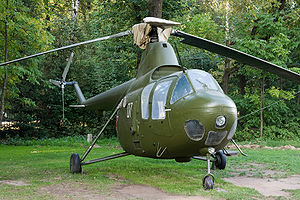
Picture - Mil Mi-1U
Role: Helicopter
Manufacturer: Mil Moscow Helicopter Plant
First flight: 20 September 1948
Introduction: 1950
Primary user: Soviet Air Force
Number built: >2,594
Variants: PZL SM-2
The Mil Mi-1 ( (USAF/DoD reporting name "Type 32", NATO reporting name "Hare") was a Soviet three- or four-seat light utility helicopter. It was the first Soviet helicopter to enter serial production. It is powered by one 575 hp Ivchenko AI-26V radial. It entered service in 1950 and was first seen on the 1951 Soviet Aviation Day, Tushino and was produced for 16 years. More than 1,000 were built in the USSR and 1,594 in Poland, as SM-1.
Development
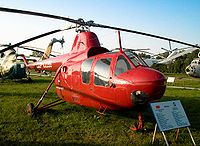
Picture - Mil Mi-1M
Mikhail Mil began work on rotary-winged aircraft before 1930, but the Mi-1, his first production helicopter, was begun in 1946, under a designation EG-1. In 1947 Mil became a head of OKB-4 design bureau in Tushino, and works were intensified. A final design was named GM-1 (for Gelikopter Mila). Its design owed much to the Sikorsky S-51 and Bristol 171, with almost identical main rotor to the British machine and similar shafting and clutch. The prototype completed first free flight on 20 September 1948 (pilot Mikhail Baikalov). In 1949 it underwent official state trials. Despite crashes of two prototypes, the design was overally successful and after further work, was ordered for a production, under a new designation Mi-1, for Mil initials. The production was initially limited - the first series of only 15 machines was ordered on 21 February 1950, in factory No.3 in Moscow. Only after presentation to Joseph Stalin in 1951, the authorities decided to increase production. In 1952-1953, 30 Mi-1 were manufactured in Kazan, and from 1954 a mass production started in Orenburg and from 1956 in Rostov. The design was a subject of further improvements during production, mostly increasing reliability. Especially a rotor technology was changing. Period between repair increased to 300 hours in Mi-1T (hence a letter T for trekhsotchasovoi), 600 in Mi-1A, then to 1000 and 3000 hours by the end of production.
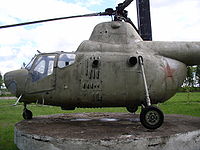
Picture - Some early three-seater Mi-1 variant
All early variants seated pilot in front and two passengers behind him, in common cabin. The first production variant was Mi-1, quickly replaced by improved Mi-1T, that carried extra operational equipment including full radio and blind-flying instruments, and had more reliable engine AI-26V. The next basic variant was Mi-1A of 1957, with further increased reliability and provisions for one 160 l external fuel tank.
New major variant, Mi-1M of 1957, introduced enlarged cabin and slightly stronger engine AI-26VF, what allowed to accommodate three passengers on a bench behind the pilot. Cabin height increased from 1.22 to 1.26 m and width from 1.01 to 1.2 m. Most noticeable difference was horizontal bottom windows' line instead of slanted, with bigger rear side windows, and less pointed fuselage nose. It could also be fitted with two external side capsules for the injured or mail. There were trials of armed variants, but they were unsuccessful due to small payload.
Well over 1000 of all variants were built in the USSR, including a proportion of dual-control trainers: Mi-1U, TU, AU, MU, with instructor seated behind a trainee. 15 were produced in Moscow in 1950, 30 in Kazan in 1952-1953, 597 in Orenburg in 1954-1958 and 370 in Rostov in 1956-1960. In 1956 license-production of the four-seat model began in Poland, at WSK PZL-Åwidnik, where 1,594 were built in about ten years, under a designation SM-1. Several new versions were developed at Åwidnik, including the SM-2 five-seater, with a new fuselage.
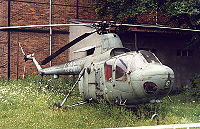
Picture - Four-seater Mi-1M
Variants
GM-1
The original designation of the Mil Mi-1 prototypes, powered by a AI-26GR 500-550 hp radial engine (later AI-26GRF).
Mi-1
Three-seat light general-purpose helicopter, seating a pilot and two passengers, powered by a AI-26GRF 575 hp radial piston engine. Initial production model.
Mi-1T
Three-seat general-purpose transport helicopter, seating a pilot and two passengers, powered by a AI-26V radial piston engine.
Mi-1KR (TKR)
Light reconnaissance and liaison helicopter of 1956, basing on Mi-1T.
Mi-1NKh
Three-seat general-purpose utility helicopter, basing on Mi-1T. Designed to be used as an agricultural aircraft, air ambulance, passenger transport, air mail, freight transport helicopter (NKh - narodnoye khozyastvo - National Economy).
Mi-1A
Three-seat general-purpose transport helicopter of 1957, seating a pilot and two passengers, with increased reliability.
Mi-1AKR
Light reconnaissance and liaison helicopter, basing on Mi-1A.
Mi-1U/TU/AU/MU
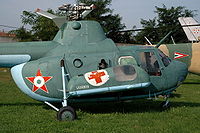
Picture - Mi-1M with side capsules for the injured
Dual-control training helicopter variants (respectively, of basic Mi-1, T, A and M models).
Picture - SM-1 (Polish produced Mi-1)
SM-1
Polish production version, powered by a LiT-3 radial piston engine. The Mil Mi-1 helicopter built by WSK PZL-Åšwidnik under licence in Poland.
SM-1/600
Polish production version with increased reliability, of 1957.
SM-1W
Polish production version of the Mi-1M(MNKh), of 1960.
SM-1WS
Air ambulance helicopter.
SM-1WSZ
Dual-control training helicopter.
SM-1WZ
Agricultural helicopter.
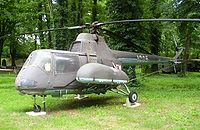
Picture - SM-2
SM-2Operators
Military operators
Afghanistan
Afghan Air Force - 12 acquired from 1957 and withdrawn from service by 1976.
Albania
Albanian Air Force - 3 in service from 1957 through 1960.
Algeria
Algerian Air Force
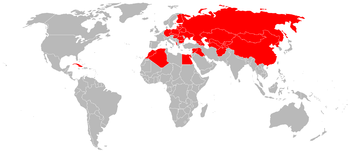
Picture - Mi-1 operators
China Cuba
Cuban Air Force
Czechoslovakia
Czechoslovakian Air Force
East Germany
East German Air Force
Egypt
Egyptian Air Force
Finland
Finnish Air Force - 4 in service 1961-1967.
Hungary
Hungarian Air Force
Iraq
Iraqi Air Force
Mongolia
Mongolian People's Air Force
North Korea
North Korean Air Force
Poland
Polish Air Force
Polish Navy
Romania
Romanian Air Force - SM-1
Soviet Union
Soviet Air Force
Soviet Army Aviation
Syria
Syrian Air Force
Civil operators
Czechoslovakia
Slov-Air
Romania
TAVS - SM-1
Soviet Union
Aeroflot
Specifications (Mil Mi-1)
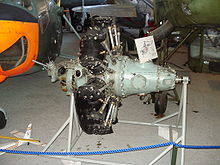
Picture - Polish-made Ivchenko AI-26V engine from SM-1
General characteristics
Crew: One
Capacity: 2 passengers or 255 kg (561 lb) of cargo
Length: 12.09 m (39 ft 8 in)
Rotor diameter: 14.35 m (47 ft 1 in)
Height: 3.30 m (10 ft 10 in)
Disc area: 161.7 m² (1,740 ft²)
Empty weight: 1,700 kg (3,740 lb)
Loaded weight: 2,140 kg (4,708 lb)
Max takeoff weight: 2,330 kg (5,126 lb)
Powerplant: 1x Ivchenko AI-26V radial engine, 429 kW (575 hp)
Performance
Maximum speed: 185 km/h (115 mph)
Range: 430 km (268 mi)
Service ceiling: 3,500 m (11,480 ft)
Rate of climb: 5.3 m/s (1,043 ft/min)
Disc loading: 13 kg/m² (3 lb/ft²)
Power/mass: 0.20 kW/kg (0.12 hp/lb)
Related development
Mil Mi-3
Comparable aircraft
Sikorsky H-5
Grzegorzewski, Jerzy: ÅmigÅowiec Mi-1, Typy Broni i Uzbrojenia nr.38, MON, Warsaw, 1975 (Polish)
http://www.aviation.ru/Mi/#1
Mil Mi-1 Pictures
Living Warbirds: The best warbirds DVD series.
Source: WikiPedia